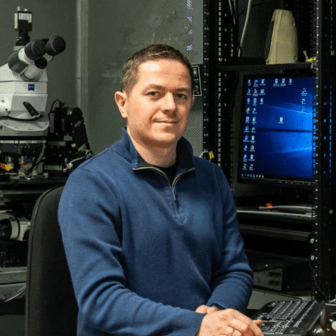The brain’s remarkable ability to adapt and change, known as plasticity, is a cornerstone of learning and memory. At the heart of this process is the modulation of synaptic strength, which enables the brain to encode transient sensory experiences into long-lasting memory traces. My research aims to explore the molecular mechanisms underlying the long-term modifications in synaptic strength that occur during learning.
During my PhD (2009-2014) in the laboratory of Prof. J. Mozrzymas, I focused on the role of the extracellular matrix protease MMP9 in hippocampal excitatory synaptic plasticity, particularly in the mossy fiber projections to the CA3 region (Wiera et al., 2012, 2013, 2015a, 2015b). This pathway is essential for spatial memory, contextual memory, and pattern separation during memory formation. Building on this foundation, my research expanded to investigate the role of MMP3, another extracellular protease, in synaptic plasticity mediated by voltage-gated calcium channels (Wiera et al., 2017).
Currently, my work focuses on the molecular mechanisms of plasticity in inhibitory synapses, supported by SONATA (2017-2022) and OPUS (2014-present) grants from the Polish National Science Center. Our recent studies have revealed complex mechanisms of long-term plasticity in GABAergic synapses (Wiera, Lebida et al., 2021; Wiera, Brzdak, et al., 2022; Wiera et al., 2024; Jablonska, Wiera, et al., 2024), challenging the traditional focus on excitatory synaptic plasticity as the main substrate for learning and memory. However, the principles underlying this newly discovered inhibitory plasticity remain poorly understood, and we aim to address several key questions:
- What forms of neuronal network activity trigger GABAergic plasticity in vivo?
- How does the diversity of interneurons influence the synapse-specificity of inhibitory plasticity?
- What molecular mechanisms mediate crosstalk between excitatory and inhibitory synaptic plasticity?
GABAergic plasticity, including phenomena such as iLTP (inhibitory long-term potentiation) and iLTD (inhibitory long-term depression), diverges from conventional excitatory plasticity in several important ways. One key difference is the heterosynaptic induction mechanism, in which non-stimulated GABAergic synapses undergo plastic changes in response to the activation of nearby excitatory synapses. Most experimental approaches for inducing iLTP or iLTD involve the exogenous application of NMDA, which is far from physiological. Therefore, there is a critical need to develop paradigms that more accurately reflect natural conditions and induce learning-related GABAergic plasticity. Our current central hypothesis is that inhibitory plasticity is induced by excitatory behavioral timescale plasticity.
- Matrix metalloproteinase-3 in brain physiology and neurodegeneration. [AUT.] ANNA MARIA LECH, GRZEGORZ WIERA, JERZY MOZRZYMAS.
Adv.Clin.Exp.Med. 2019 Vol.28 no.12 s.1717-1722, bibliogr. 60 poz. summ. DOI: 10.17219/acem/110319 - Mechanisms of NMDA receptor- and voltage-gated L-type calcium channel-dependent hippocampal LTP critically rely on proteolysis that is mediated by distinct metalloproteinases. [AUT.] GRZEGORZ WIERA, DARIA NOWAK, INGE VAN HOVE, PIOTR DZIĘGIEL, LIEVE MOONS, JERZY W. MOZRZYMAS.
J.Neurosci. 2017 Vol.37 no.5 s.1240-1256, ryc. bibliogr. summ. DOI: 10.1523/JNEUROSCI.2170-16.2016 - Multifaceted roles of metzincins in CNS physiology and pathology: from synaptic plasticity and cognition to neurodegenerative disorders. [AUT.] PATRYCJA BRZDĄK, DARIA NOWAK, GRZEGORZ WIERA, JERZY W. MOZRZYMAS.
Front.Cell.Neurosci. 2017 Vol.11 art.178 [22 s.], ryc. bibliogr. summ. DOI: 10.3389/fncel.2017.00178 - Overexpression of STIM1 in neurons in mouse brain improves contextual learning and impairs long-term depression. [AUT.] ŁUKASZ MAJEWSKI, FILIP MACIĄG, PAWEŁ M. BOGUSZEWSKI, IGA WASILEWSKA, GRZEGORZ WIERA, TOMASZ WÓJTOWICZ, JERZY MOZRZYMAS, JACEK KUŹNICKI.
Biochim.Biophys.Acta Mol.Cell Res. 2017 Vol.1864 no.6 s.1071-1087, ryc. bibliogr. 121 poz. summ. DOI: 10.1016/j.bbamcr.2016.11.025 - Extracellular proteolysis in structural and functional plasticity of mossy fiber synapses in hippocampus. [AUT.] GRZEGORZ WIERA, JERZY W. MOZRZYMAS.
Front.Cell.Neurosci. 2015 Vol.9 art.427 [21 s.], ryc. bibliogr. 277 poz. summ. DOI: 10.3389/fncel.2015.00427 - Impact of matrix metalloproteinase-9 overexpression on synaptic excitatory transmission and its plasticity in rat CA3-CA1 hippocampal pathway. [AUT.] GRZEGORZ WIERA, MARCIN SZCZOT, TOMASZ WÓJTOWICZ, KATARZYNA LEBIDA, P. KOZA, JERZY W. MOZRZYMAS.
J.Physiol.Pharmacol. 2015 Vol.66 no.2 s.309-315, ryc. bibliogr. 37 poz. summ. - Maintenance of long-term potentiation in hippocampal mossy fiber-CA3 pathway requires fine-tuned MMP-9 proteolytic activity. [AUT.] GRZEGORZ WIERA, GRAŻYNA WOŹNIAK, MAŁGORZATA BAJOR, LESZEK KACZMAREK, JERZY W. MOZRZYMAS.
Hippocampus 2013 Vol.23 no.6 s.529-543, ryc. bibliogr. 52 poz. summ. DOI: 10.1002/hipo.22112 - Long term potentiation affects intracellular metalloproteinases activity in the mossy fiber - CA3 pathway. [AUT.] GRZEGORZ WIERA, TOMASZ WÓJTOWICZ, KATARZYNA LEBIDA, ALEKSANDRA PIOTROWSKA, DOMINIKA DRULIS-FAJDASZ, AGNIESZKA GOMUŁKIEWICZ, DARIA GENDOSZ, MARZENNA PODHORSKA-OKOŁÓW, MARCO CAPOGNA, GRZEGORZ WILCZYŃSKI, PIOTR DZIĘGIEL, LESZEK KACZMAREK, JERZY W. MOZRZYMAS.
Mol.Cell.Neurosci. 2012 Vol.50 no.2 s.147-159, ryc. bibliogr. 49 poz. summ, Erratum: Mol.Cell.Neurosci. 2013 Vol.52 s.181-182.
- 2017 – team prize awarded by the Rector of the Medical University in Wroclaw
- 2016/2017 – START Scholarship awarded by the Foundation for Polish Science
- 2013/2014 – Ludwik Hirszfeld scholarship in the field of biological and medical sciences
- 2014 – FENS travel grant
- 2013 - First prize for the best conference report awarded by the Biomedical Engineering Commission of the Wroclaw Branch of the Polish Academy of Sciences during the 4th Symposium of the Polish Academy of Sciences (June 2013) for the paper: "The influence of extracellular matrix proteinase activity on synaptic plasticity in the hippocampus - electrophysiological studies"
- 2012/2013 - EU scholarship from the Wroclaw University program "Development of the potential and educational offer of the University of Wroclaw as a chance to increase the University's competitiveness" combined with an internship at the A. Barberis Laboratory in Genoa
- 2011/2012; 2012/2013; 2013/2014 - Research scholarship by the Rector of the University of Wroclaw for the best PhD students
- Grant OPUS funded by Polish National Science Centre „ Behavioral timescale plasticity in inhibitory synapses: mechanisms and implications”
2025-2028
Budget: 2 751 181 PLN - Grant SONATA funded by Polish National Science Centre „Tetrapertite inhibitory synapse - the role of extracellular matrix, adhesion proteins and astrocytes in the plasticity of GABAergic synapses”
2018-2022
Budget: 1 163 400 PLN - Research subsidy and scholarship ETIUDA funded by Polish National Science Centre; "The impact of extracellular matrix modification on synaptic plasticity of the hippocampal moss fiber - CA3 projection"
X 2013 – IX 2014
Budget: 78 000 PLN
 Szukaj
Szukaj


